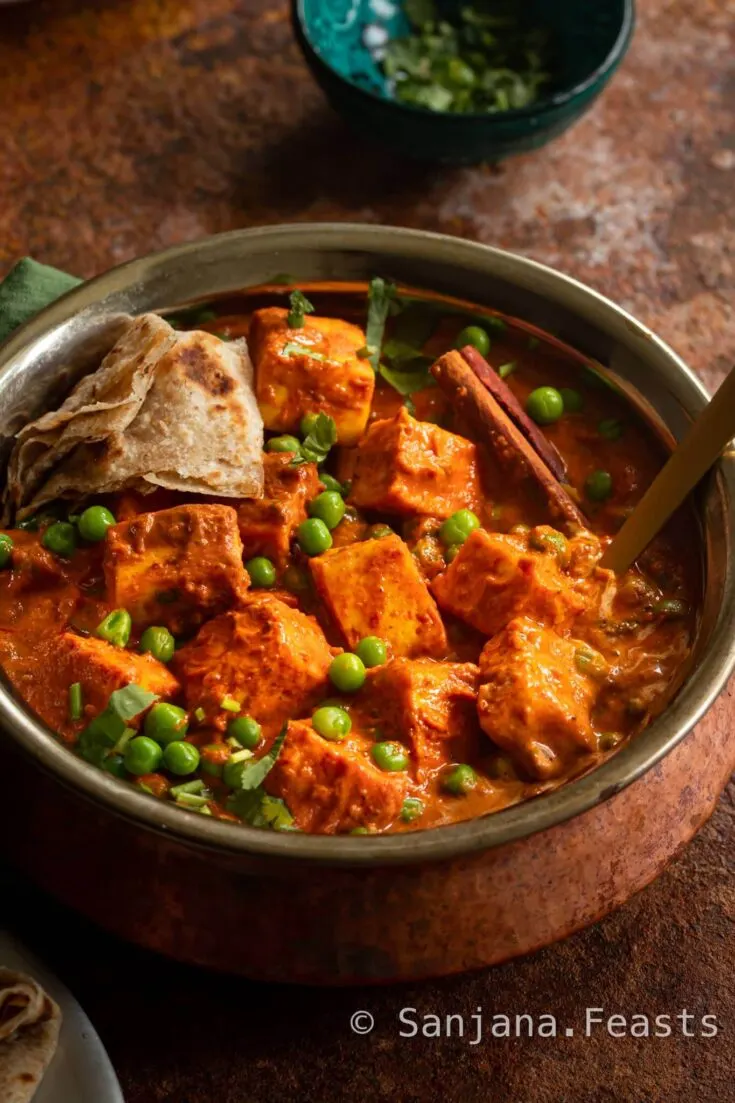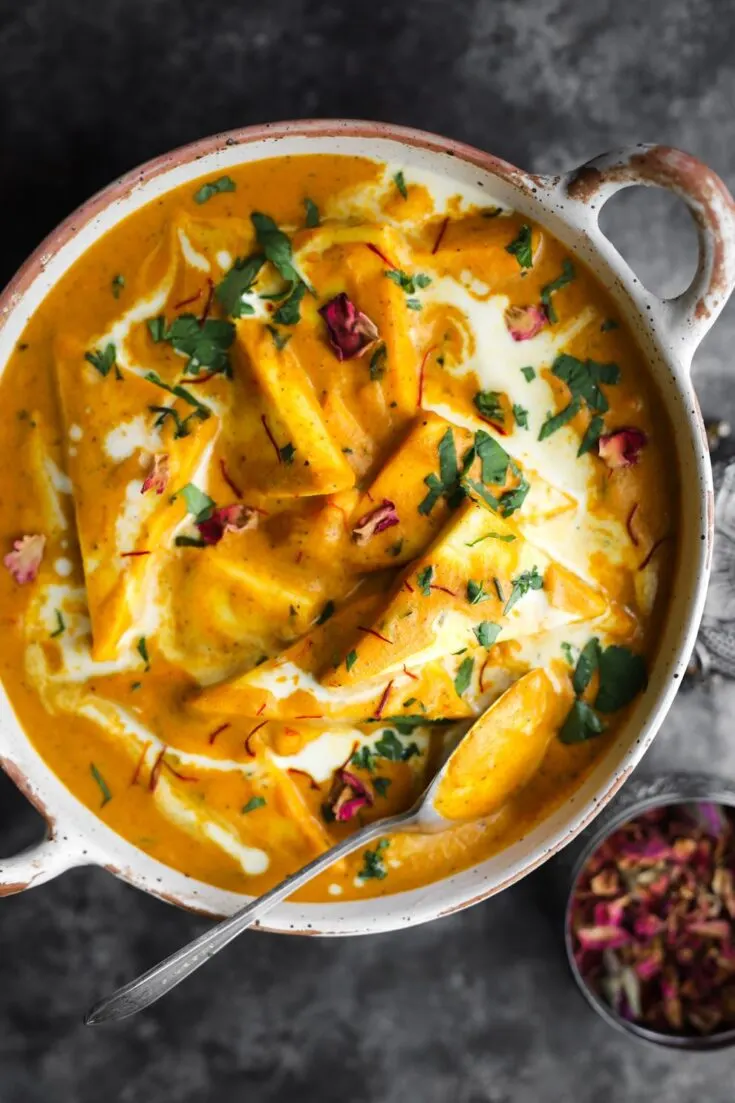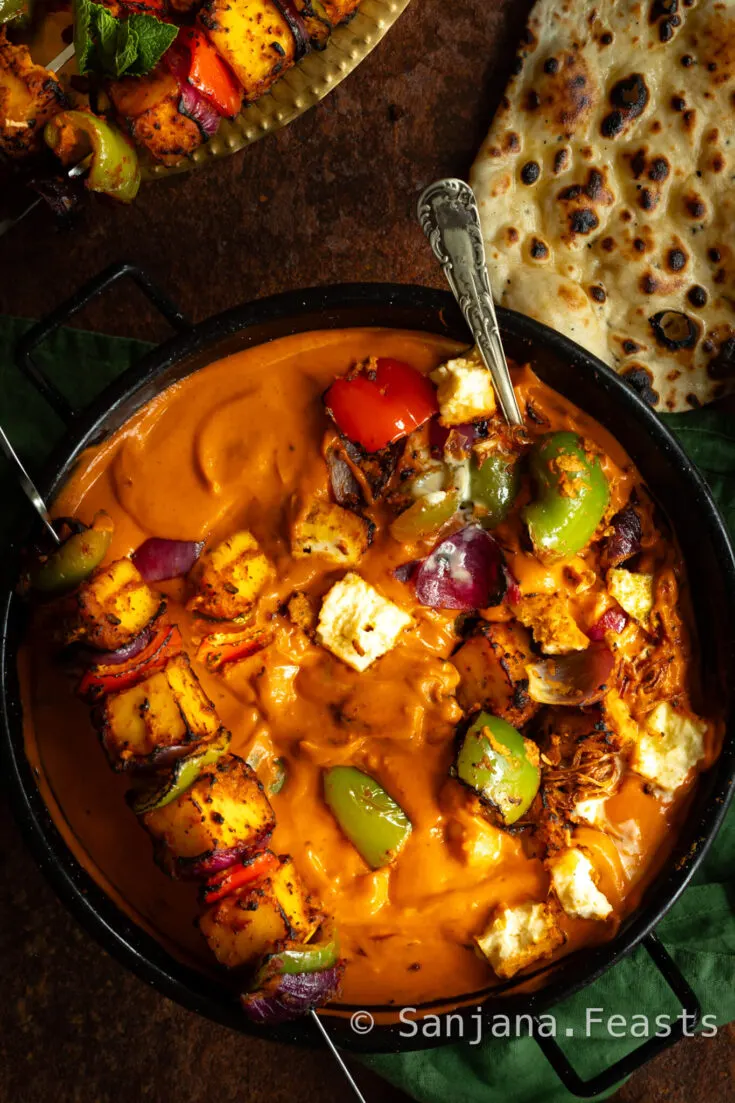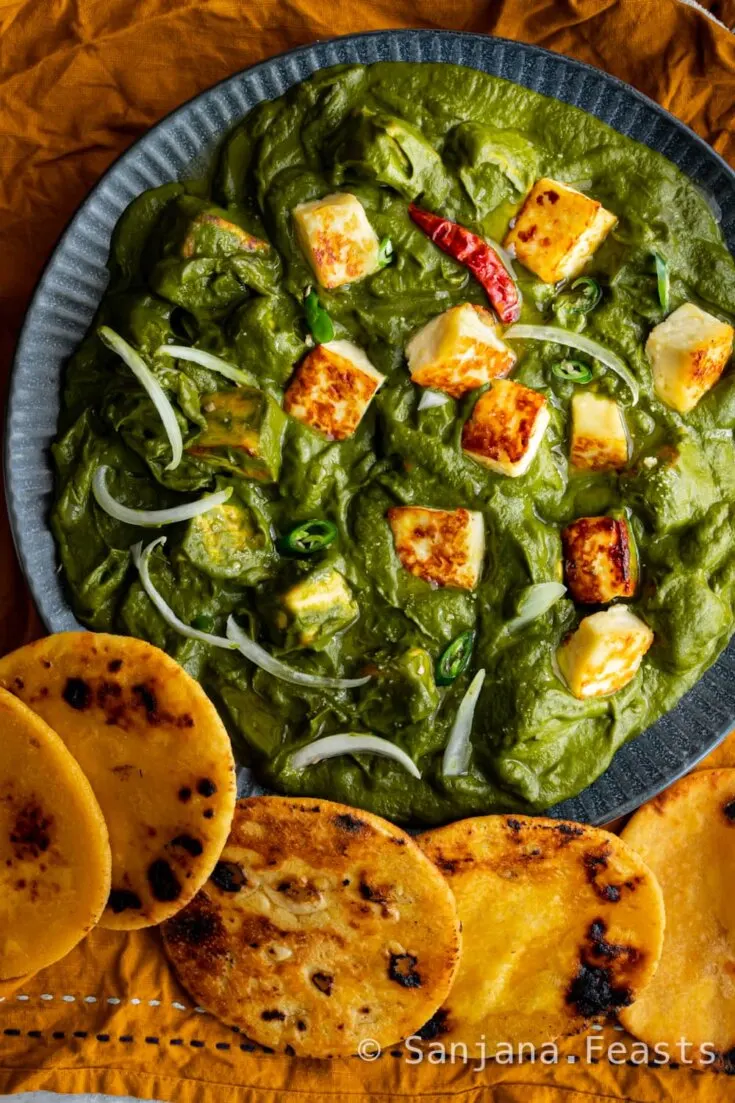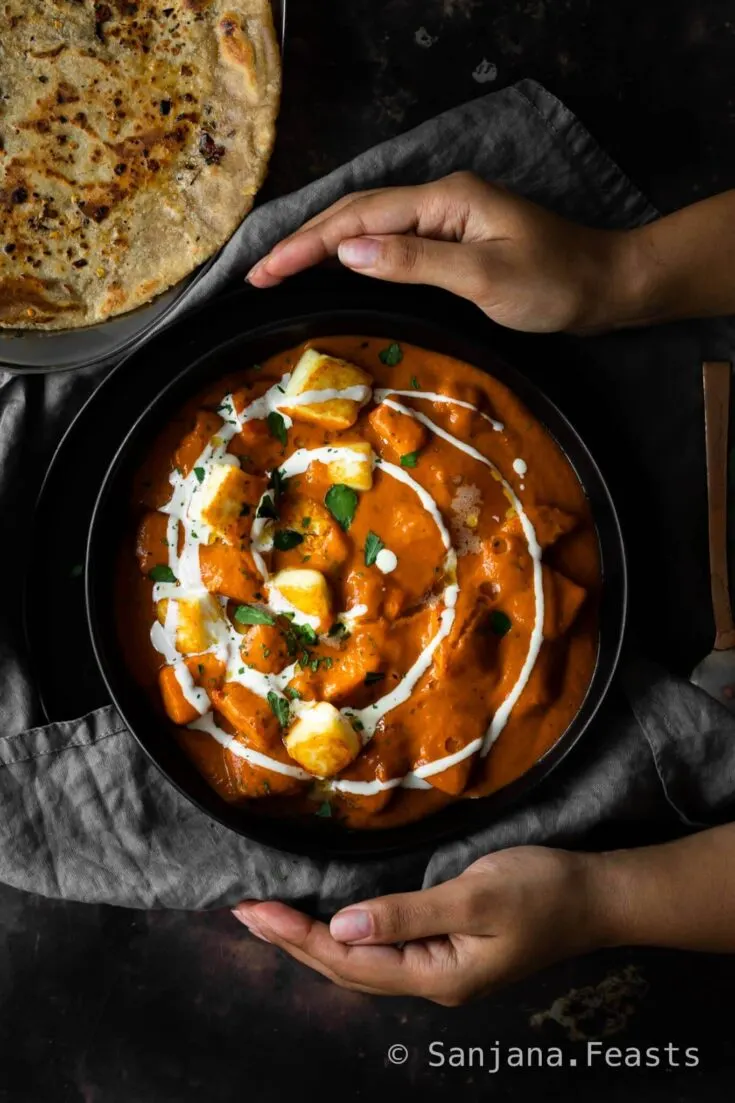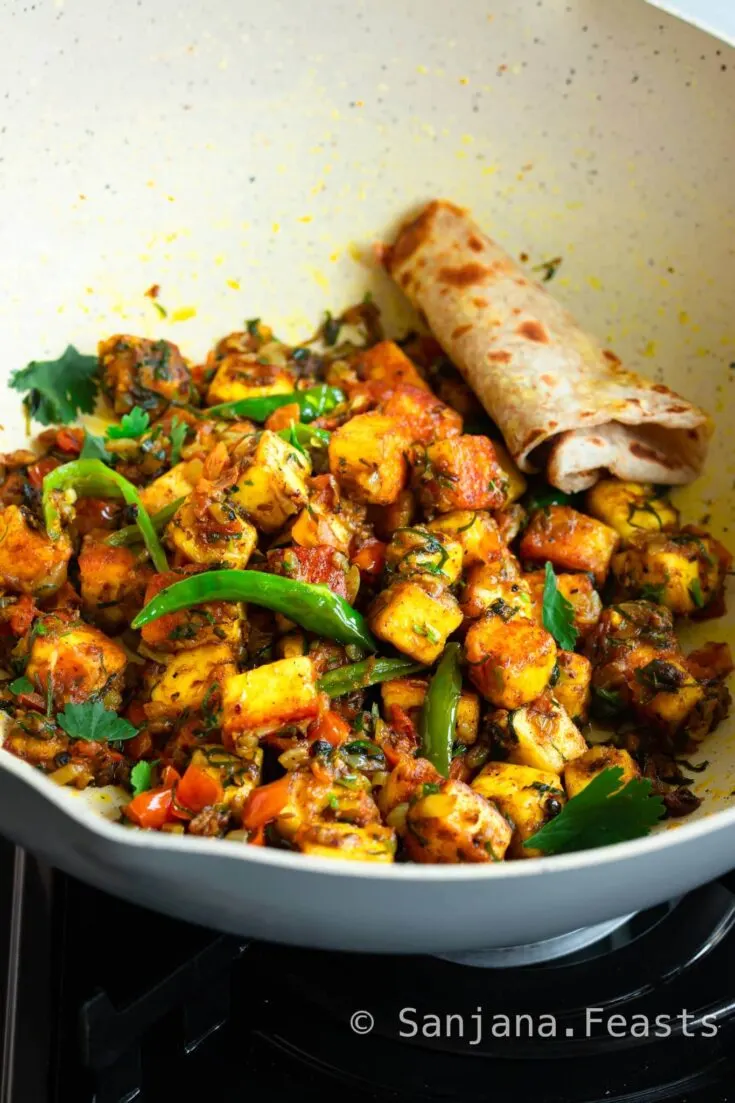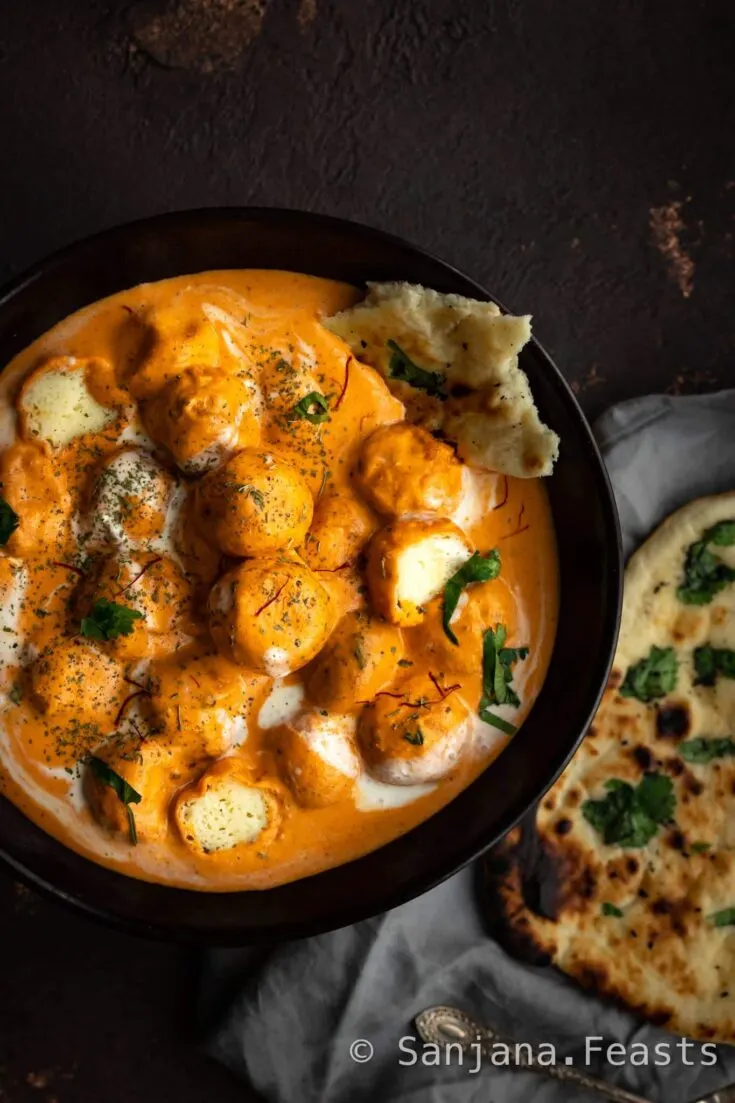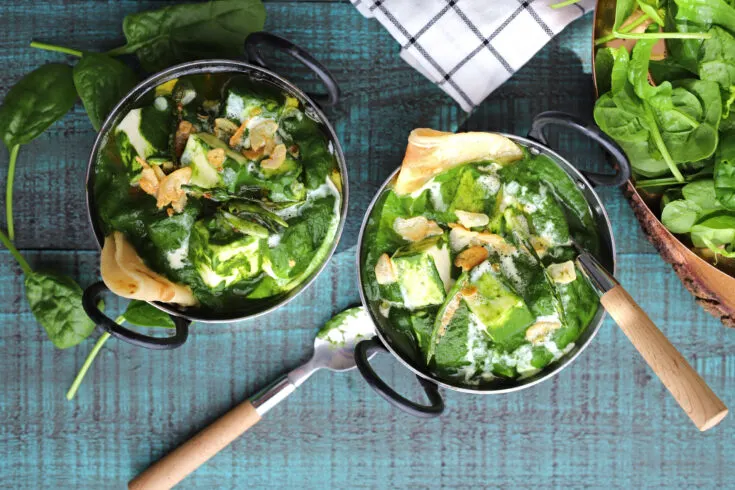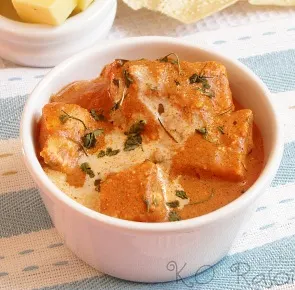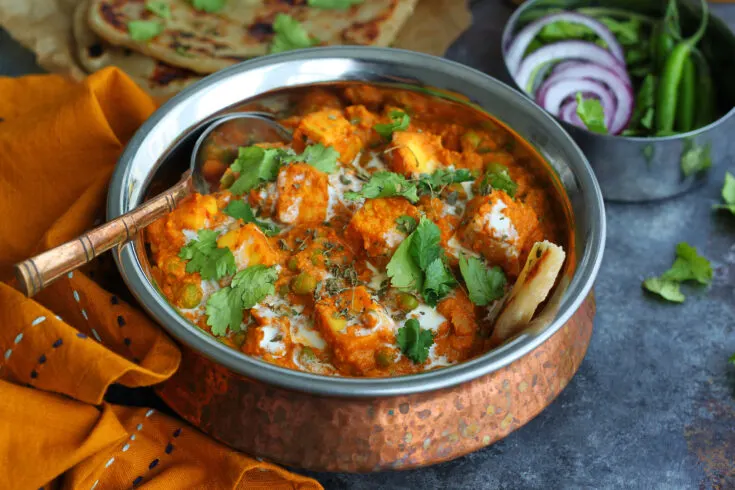A delicious and nutritious Vegetable Curry recipe. This aromatic recipe for Vegetable Curry is also easy to prepare, making it an amazing option for home cooks or people new to Indian food.
Prepare this dish with any veggies you have in the fridge, freezer or pantry.
Vegetable Curry is typically served with rice, naan, paratha or roti, but feel free to choose your favourite accompaniments.
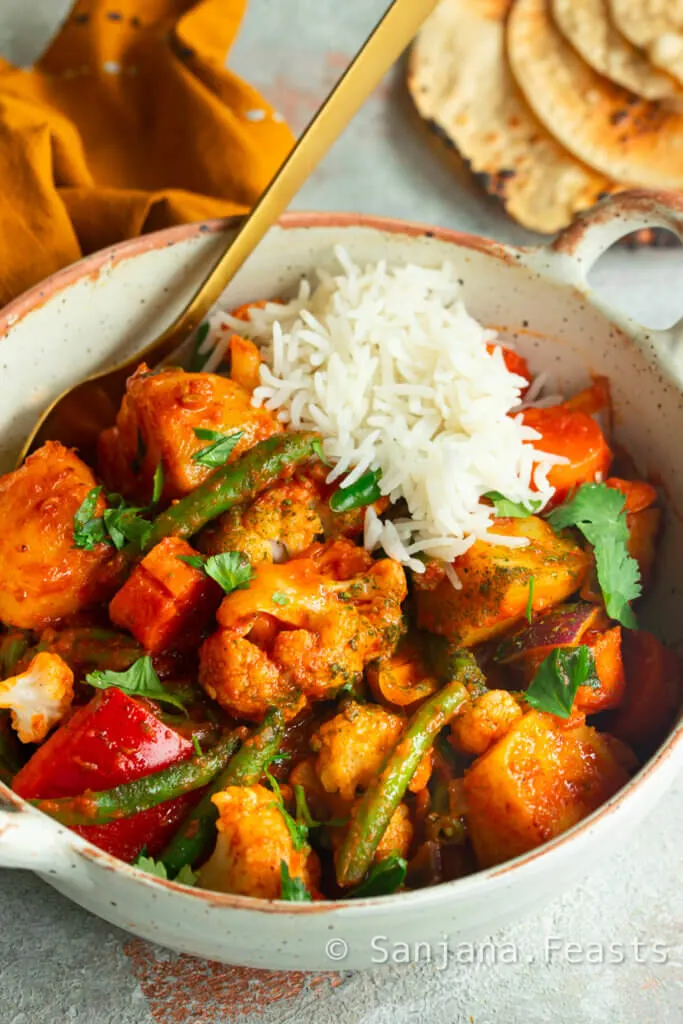
This Vegetable Curry Recipe is…
- Easy
- Versatile – use any vegetable you have!
- Traditional, with aromatic Indian flavours
- Vegetarian
- Gluten free
Vegetable Curry for a crowd


The beauty of vegetable curry lies in its adaptability. Use seasonal veg to make a budget-friendly meal.
Here’s a home-style Indian vegetable curry recipe that’s a total crowd pleaser. It’s easy to scale up or down for batch cooking and dinner parties.
You can also make it spicy or mild, depending on your taste.
This veggie curry recipe is not only delicious, but is also relative to what’s in your fridge, freezer or pantry.
Which vegetables to put in curry?
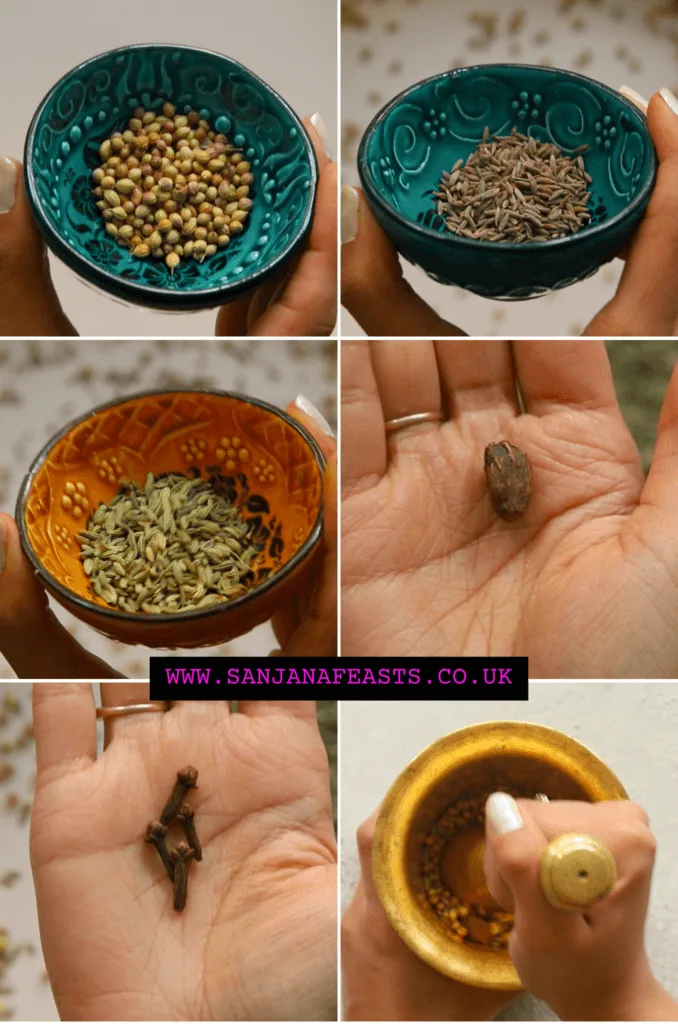
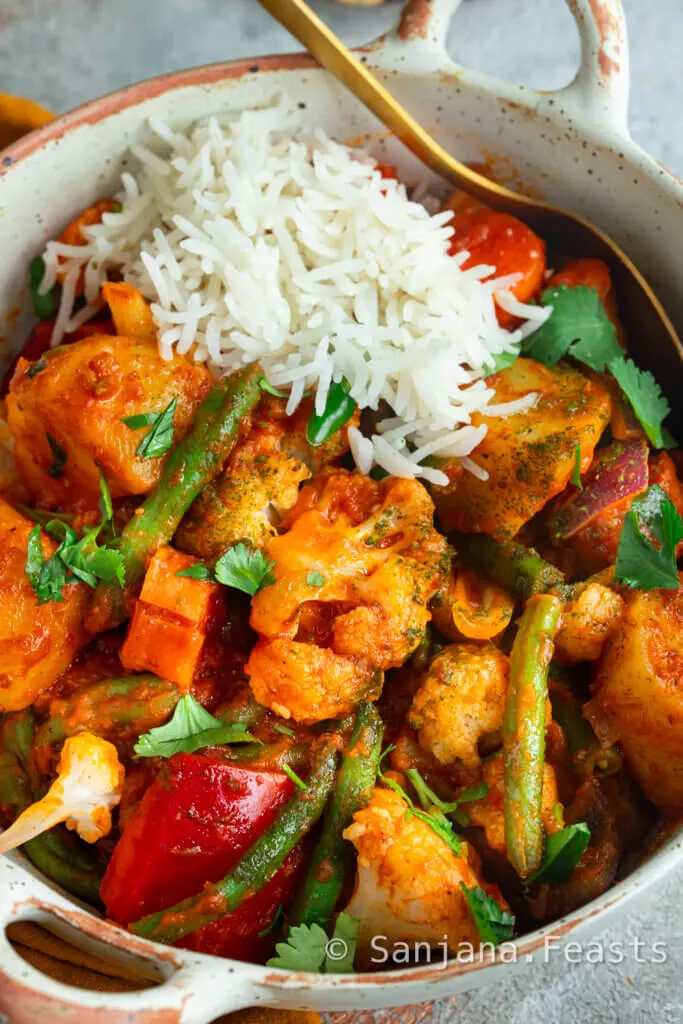
- Sturdy veggies: Potatoes, carrots, peas, and green beans hold their shape well in a curry and add a satisfying bite.
- Creamy veggies: Cauliflower, courgette (zucchini), and aubergine (eggplant) become beautifully tender and add a touch of creaminess to the curry.
- Flavour boosters: Bell peppers, onions, and tomatoes add pops of colour and sweetness to the dish. They also play a role in building the base flavour of the curry.
Other options:
- Leafy greens: Tender greens like spinach or kale can be added towards the end of cooking for a quick wilt and extra nutrients.
- Root vegetables: Butternut squash, sweet potato, and turnips add a touch of sweetness and earthiness to the curry.
- Asian vegetables: Explore options like baby corn, okra, cluster beans, and long beans for a unique texture and flavour profile.
Tips:
- Consider cooking time: If using vegetables with different cooking times, pre-cook the harder vegetables (like potatoes) before adding them to the curry.
- Think about texture: For a well-rounded curry, include a mix of soft and crunchy vegetables.
- Don’t be afraid to experiment! The possibilities are endless.
Give you Vegetable Curry a boost of protein!
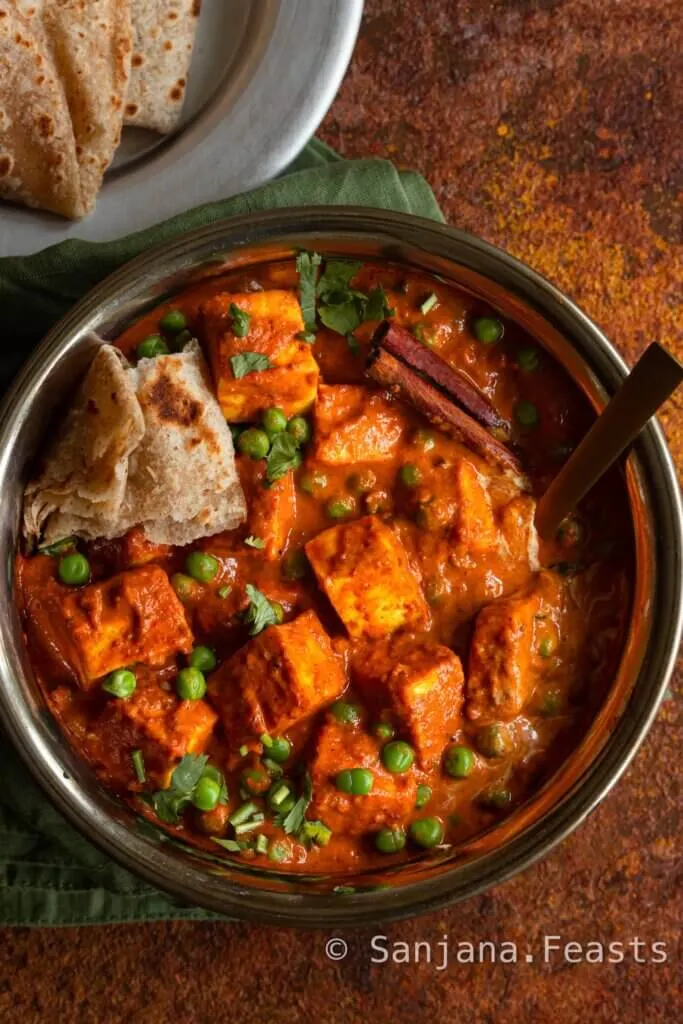

Increase the protein content of your vegetable curry by swapping a handful of vegetables with a handful of beans, lentils, paneer or tofu.
How to make a vegan version
For a vegan option, use soy or oat cream in place of double cream.
Can you freeze vegetable curry?
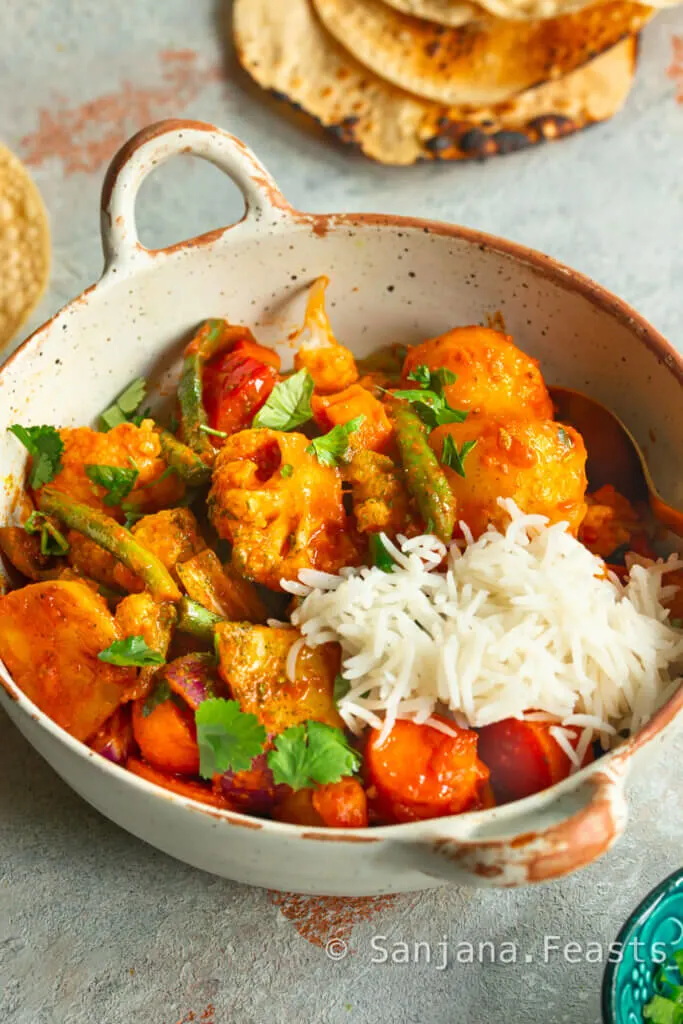
To freeze: Pack the curry into a freezer-safe container and freeze for up to 3 months. Defrost at room temperature or in a pan fitted with a lid. Ensure the curry is piping hot before serving.
Note that if you add starchy root vegetables like potatoes to vegetable curry, they may loose some of their texture from being frozen and defrosted.
Consider skipping them and adding chickpeas, butter beans or aubergines instead.
More vegetable curry recipes
- Matar Paneer recipe
- Spinach and Mushroom Curry recipe
- Cabbage & Potato Curry recipe
- Mung Bean Curry recipe
What to serve with Vegetable Curry

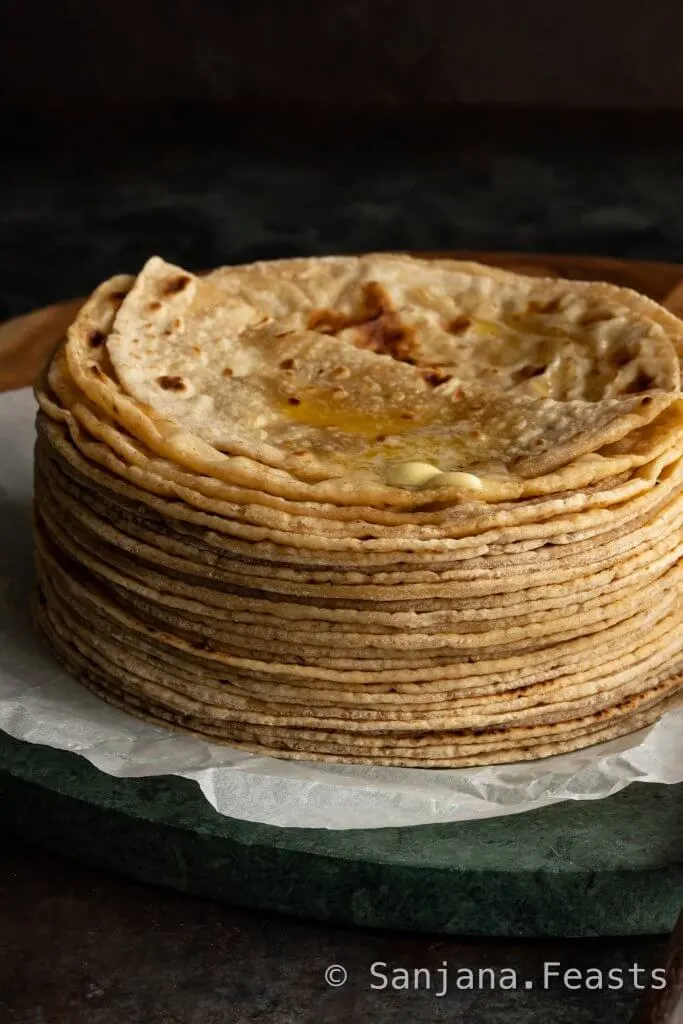

- Rice: Basmati rice is a fluffy and fragrant choice that perfectly soaks up the curry sauce. You can also opt for brown rice for a fibre-rich option.
- Flatbreads: Naan and roti are soft flatbreads traditionally served with Indian curries. They’re perfect for scooping up all the goodness.
Refreshing Sides:
- Raita: This cooling yogurt-based condiment with cucumber, mint, or other vegetables is a classic Indian accompaniment to curry. It provides a refreshing contrast to the spicy flavors.
- Salad or Kachumber: A simple green salad with a light vinaigrette is a great way to add some greens and freshness to your meal.
Indian Vegetable Curry Recipe | How to Make Vegetable Curry
Vegetable Curry Recipe

A delicious and nutritious Vegetable Curry recipe. This recipe for Vegetable Curry is also easy to make, making it an amazing option for home cooks or people new to Indian food. Prepare this dish with any veggies you have in the fridge, freezer or pantry. Vegetable Curry is typically served with rice, naan, paratha or roti, but feel free to choose your favourite accompaniments.
Ingredients
- 800g mixed vegetables of your choice (I used potatoes, cauliflower, peas and carrots)
- 3 tbsp any unflavoured oil
- 2 large onions, peeled and finely diced
- 3 large cloves garlic, peeled and minced
- 2 tsp minced ginger
- 2 tsp coriander seeds
- 1 tsp cumin seeds
- 1 tsp fennel seeds
- 4 cloves
- 1 black cardamom
- 1 large cinnamon stick
- 1 tsp turmeric
- 2 tsp Kashmiri chilli powder
- 500g tomato passata or canned chopped tomatoes
- 1 1/2 tsp garam masala
- 1 tsp sugar
- 1 /2 tsp salt, or to taste
- 150ml double cream
- 300-400ml hot water to adjust the consistency of the curry
- 1 tsp kasoori methi, rubbed between your palms or ground to a fine powder
- Fresh coriander leaves to garnish
- Sliced green chillies, to serve (optional)
Instructions
- Lightly toast the coriander, cumin, fennel, black cardamom, cloves in a dry frying pan until aromatic. Do this over a low heat and keep the spices moving all the time so they do not burn. Pile the spices into a pestle and mortar and grind to a fine powder. Set aside until needed.
- Steam or boil the vegetables until tender. Set aside.
- Place the remaining oil over a medium heat and add the cinnamon and onions. Sauté until the onions are a deep golden brown colour, about 8 minutes. Add a pinch of the measured salt to help the onions caramelise faster.
- Next, add ginger, garlic and tomatoes. Bring the mixture to a gentle simmer and then add in all the homemade spice mixture, as well as the turmeric, chilli powder, garam masala, sugar and remaining salt. Cover the pan with a tight fitting lid and simmer over a medium heat for 15 minutes.
- Remove the lid, stir well and add cream. Mix the cream in quickly and thoroughly. Adjust the consistency of the sauce with hot water if necessary. The amount you add will depend on how saucy you want the Matar Paneer. I added around 350ml.
- Add the cooked vegetables, kasoori methi, coriander and green chillies if using. Stir well and heat through for 4-5 minutes before serving.
Notes
- Store leftovers in an airtight container, refrigerated for up to 3 days.
- To freeze: Pack the curry into a freezer-safe container and freeze for up to 3 months. Defrost at room temperature or in a pan fitted with a lid. Ensure the curry is piping hot before serving.
- Boost the protein content of your vegetable curry by swapping a handful of vegetables with a handful of beans, lentils, paneer or tofu.
- For a vegan option, use soy or oat cream in place of double cream.
Nutrition Information:
Yield: 4 Serving Size: 1Amount Per Serving: Calories: 435Total Fat: 29gSaturated Fat: 10gTrans Fat: 1gUnsaturated Fat: 17gCholesterol: 61mgSodium: 2512mgCarbohydrates: 36gFiber: 12gSugar: 15gProtein: 15g
If you like this, you’ll love my recipe for Easy Spinach Curry with Mushrooms
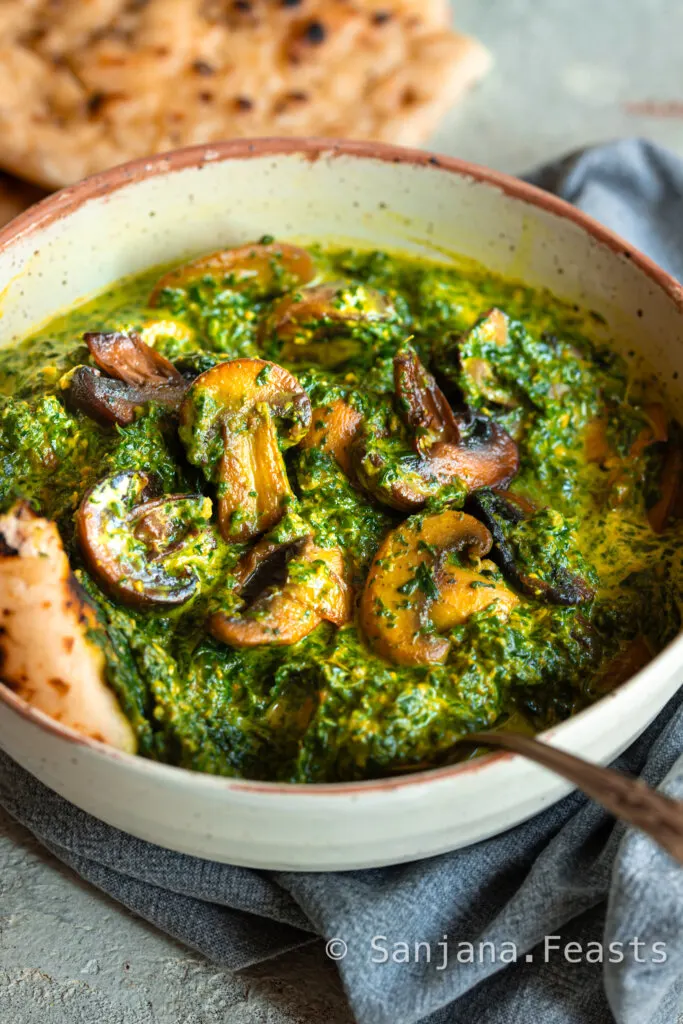
More delicious Indian curry recipes
10 Paneer Curry Recipes You'll Love
Try one of these delicious paneer curry recipes the next time you're cooking up an Indian feast!
Matar Paneer
Matar Paneer is a popular Indian dish made with paneer cheese and peas in a creamy tomato-based sauce. It's a delicious and nutritious vegetarian curry.
This recipe for Matar Paneer is also easy to make, making it an amazing option for home cooks or people new to Indian food.
Matar Paneer is typically served with rice, naan or roti, but feel free to choose your favourite accompaniments.
Restaurant-Style Shahi Paneer
Soft, creamy Mughlai Restaurant-Style Shahi Paneer is a true celebration of rich flavours and treasured spices. Scoop this vegetarian curry up with hot paratha, naan or roti.
If you’re not a bread lover, this Shahi Paneer also pairs beautifully with rice, should you wish to opt for a simple curry and rice bowl for dinner.
Paneer Tikka Masala
Learn how to make the most delicious Paneer Tikka Masala, just like your favourite Indian restaurant!
Pieces of paneer (cottage cheese) and vegetables are first marinated in yoghurt and spices, and then skewered and grilled to smoky perfection.
The tikka pieces are then removed from the skewer and folded into a creamy curry sauce made with tomatoes, spices and cream. Here's an easy to follow video recipe and video.
The Ultimate Saag Paneer
The Ultimate Saag Paneer recipe is pure MAGIC! Soft paneer chunks in a creamy mustard greens & spinach curry. Every bite will melt in your mouth.
Saag Paneer is the more character-laden cousin of Palak Paneer, made with mixed greens like mustard leaves (sarson) instead of spinach alone.
The velvety texture and subtle spicing of this recipe for Saag Paneer ensures the peppery mustard leaves and juicy paneer are the true stars of the show.
Brown Butter Paneer Makhani
I thought I knew true love, but then I met Brown Butter Paneer Makhani. The toasty, nutty aroma of brown butter (or beurre noisette) transforms the traditional Paneer Makhani we all know and love into something even more sensational.
Combine aromatic spices with a creamy cashew and tomato base, gently brown some butter in a pan and create the Makhani-style sauce of your dreams. This is the only way I’ll make Paneer Makhani from now on.
Paneer Curry
Try this easy Paneer Curry recipe with a delicious mix of aromatic Indian spices. Sauté the soft cubes of Indian cottage cheese in a golden onion and tomato masala. The flavours of cumin, black pepper, ginger and garam masala add warmth and excitement.
A kadai-fried curry like this (without too much sauce) is perfect to serve with naan, roti or paratha. I even like using it as a dosa filling when making Paneer Masala Dosa. If you prefer your Paneer Curry with a thick Indian gravy, try Paneer Makhani or Matar Paneer.
Melt-Away Malai Kofta
I call this creamy paneer kofta curry Melt-Away Malai Kofta simply because they melt away as soon as you put them in your mouth. Malai Kofta are the ultimate North Indian vegetarian curry recipe to dazzle friends and family.
My simple paneer and potato kofta are golden on the outside and a brilliant white colour on the inside. Each bite is soft, a little spongy and slick with a smooth and creamy tomato sauce. In my home, Malai Kofta is an essential curry for special occasions.
This Indian vegetarian curry of paneer (cheese) and potato kofta is a real celebration of rich flavours and warming spices.
Easy Creamy Palak Paneer
I will always order Palak Paneer if it’s on the menu in a restaurant. For me, a bowl of creamy spinach and cheese is mandatory. I could forgo rice and bread and quite simply eat a bowl of Palak Paneer with a spoon.
The trick to a super green sauce is to cook the spinach as little as possible. Just apply enough heat to wilt it at the beginning and heat the finished sauce just to warm all the ingredients through.
Paneer Butter Masala
One of my favourite paneer dishes is Paneer Butter Masala, whereby chunks of soft paneer are folded into a creamy and sharp tomato sauce made luxurious with unadulterated butter.
Hand me a teardrop sheet of puffy, soft naan to mop up all of that sauce and I’m in seventh heaven.
Restaurant-Style Matar Paneer
The soft and creamy cubes of Indian cottage cheese pairs so well with simple fresh garden peas, making this vegetarian curry a pillar of Desi restaurant and home-style cooking.
The base gravy for this Matar Paneer recipe contains ground almonds and tomatoes for a delectable creaminess and sharp tang.
The spicing is warm but complex, making you wonder if you really just made that at home in the comfort of your own kitchen, without having to go to a restaurant or pick up a takeaway menu. Mad skills.


